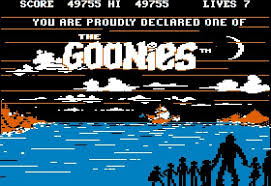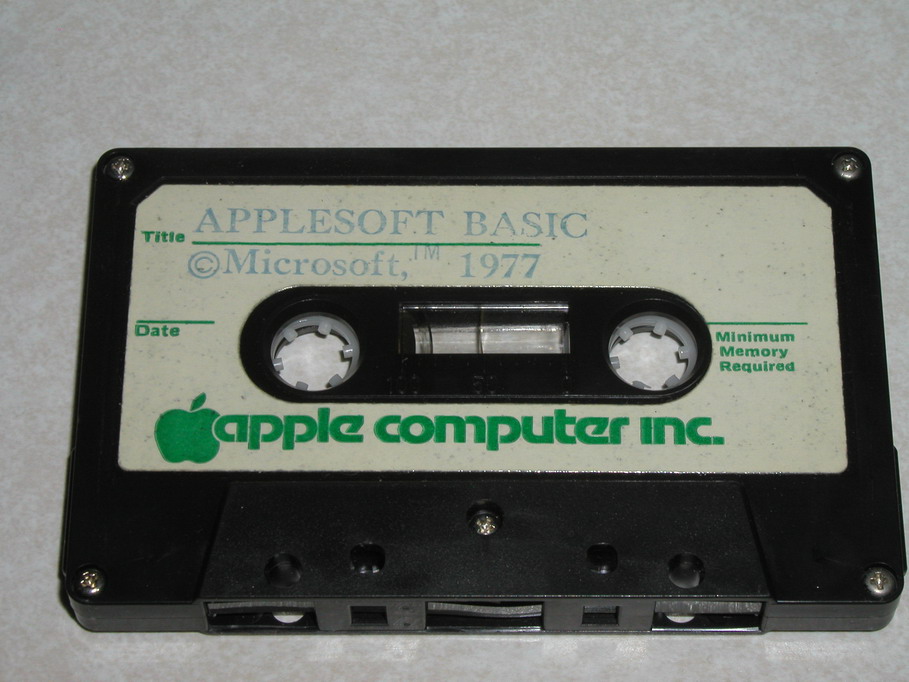
A CELEBRATION OF BASIC
BASIC?? I KNOW YOU ARE, BUT WHAT AM I?
It's been fifty years since the invention of BASIC, the line-based computer programming language that took the 80s by storm. Previously, programming was a formidable task only understood by those who spent extended hours studying every nuance of a computer's coding. Then two professors at Dartmouth engineered a way for the computer to understand a series of words in plain English that did what the writer desired. Typing PRINT followed by a message in quote marks resulted in that message being printed, fittingly enough. Everybody knew that one. They also knew how to put it to use by writing a second line of BASIC directing back to the first one, creating an endless screen of repeating messages to annoy the teacher.

The original version of BASIC for the Apple II was written by Steve Wozniak himself. In later models of the Apple the BASIC system was revised a bit by Microsoft (yes, Apple and Microsoft working together, mass hysteria) and called "Applesoft BASIC," while the original Woz version was renamed "Integer BASIC" and had to be loaded into Apples II+ and onward via disk if you wanted to run older programs. Or, if you were really primitive, the newer BASIC had to be loaded via cassette.
Here are some of the most useful BASIC words and commands in Applesoft. Even though it made using a computer a lot easier to understand then.....compared to how simple and dumbed-down the average interface is these days, BASIC must look like heiroglyphics to a modern viewer. If you want a free game, you just hold up your phone, hit a few buttons, and poof, you have a free game (or, actually, 1/64th of a game and then they manipulate you into paying for the rest). If you wanted a free game THEN, it was doable, but you had to hunt down a book full of type-in programs and feed all the information into your computer manually, with your own hands. This was part of an actual program I entered. Just PART.
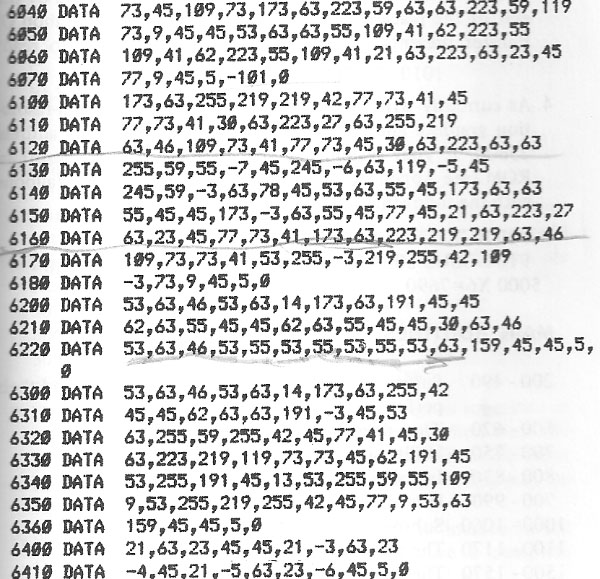
From this I got a one-minute cartoon sketch with little sprites. It took five pages' worth of code like this, but I entered it all in. I wouldn't ever do it again today, but I DID IT. I climbed vertical mountains like this line by line, into my Apple, while walking fifty miles to school IN THE SNOW.
And it was even worse than that! The Apple II had no proper editing functions in BASIC mode, which meant if you made one little typo in a line, you couldn't bring it up and change that little part. You had to type the ENTIRE LINE OVER AGAIN. But when you hit "RUN" for the final time, sat back in your chair and watched it all appear, you really felt like you had earned it. You felt a sense of pride.
Until the computer beeped at you, said ?SYNTAX ERROR and stopped everything mid-run. Time to comb the entire list for another typo.
| 3-2-1
Contact Magazine published type-in programs in every
issue. I would look at these things and try to imagine
what they were like. I could only imagine because the
programs were for Apple, IBM and Commodore 64s...and at
the time, I had a TRS-80, Radio Shack's crummy line of
'puters. I was still learning my multiplication tables and had no concept of variables or algebraic formulas. When I stared at all these letters and numbers I had no idea what it all was meant to do. I assumed entering any of these type-in programs into a computer would result in a full-fledged 16-bit game with parralax scrolling and Dolby sound appearing before my eyes. Thus, when they said the programs were only for Apple and IBM computers, I took that seriously, because why would such sophisticated games be cross-compatible? A little later on, you'll find out what "Apple FX" truly does. It's not an Ovaltine decoder pen level of disappointment, but it's close. |
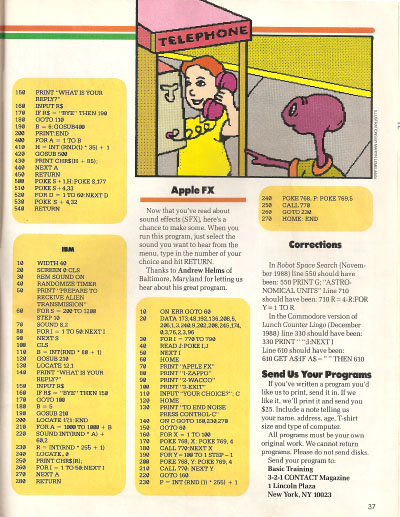 |
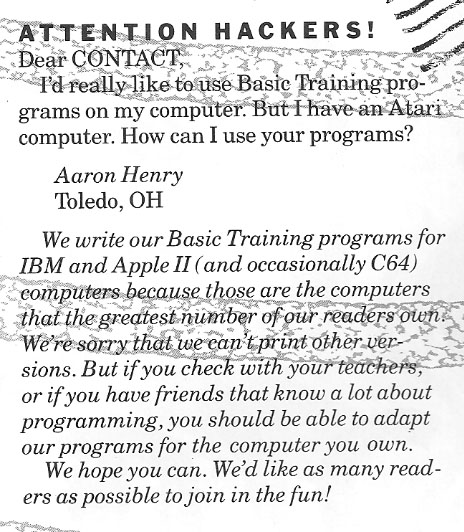 |
You can imagine my furor when somebody wrote in to the magazine mailbag expressing the exact problem I had, only to be told "don't worry, we're sure you can get them to work with a little tweaking." Who did they expect me to be, The Woz? I can't take these complicated strings of goop and recombinate them into the TRS-80 language! I'd have to be a brainiac! Here is the headbanging truth I know now. If I had just tried one of those 3-2-1 Contact programs, just entered ONE into the TRS-80 out of curiosity, I would have found out they worked fine. These were never that complicated. They were text-based games based on simple variable formulas, using words that every version of BASIC understood. You'd think I would have noticed every time the magazine suggested a line change, it was always to replace the word that cleared the screen (which was different across computer companies) and nothing else. It was really that simple the whole time and I never knew. Why didn't my parents just get me a blasted NES like everybody else? |
One afternoon, I came home from school after struggling over the new world of algebra and puzzle-based problem solving. I flipped open my TSR-80 Beginner's Basic book and looked at the programs again. That's when I noticed something I hadn't before.
FOR H = 17 TO 40
FOR V = 5 TO 11
SET (H,V,3)
Suddenly, a light went on upstairs. What if H stood for Horizontal and V stood for Vertical? Then this would make a box. It just might be true!
I went up to the attic where the TRS-80 had been banished after months of unuse. I tried a "For H, For V" program and sure enough, I got a box, by golly. A whole new world had just been opened up -- suddenly this lousy machine had possibilities!
The next morning, when the class was told to write in their journals, I wrote about my discovery to the teacher. She wrote back with implied incredulousness, "You really couldn't tell?" No, I couldn't. I thought all this time the H stood for "HF23R--FW-F-W2FR9292Y&^r$86%--MEGABYTE-TURBO-COMPLICATED-FF9-TK421."
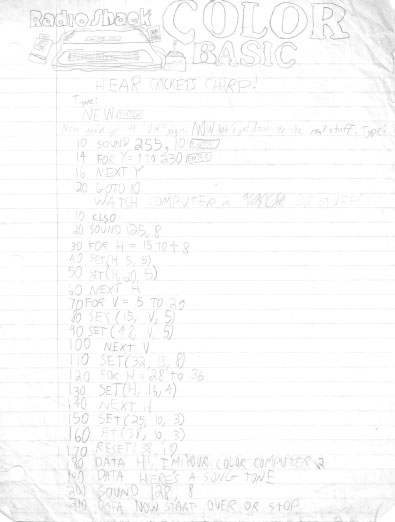
My first written BASIC program was actually before that moment, back when none of it made sense. Copyright 1991, this consists of a bunch of swiped lines of code from the Beginner's Manual that I slapped together, which just happened to do something through luck. This was a monkey-at-a-typewriter production. I had no idea what I was writing down, only that it was the only random attempt that succeeded.
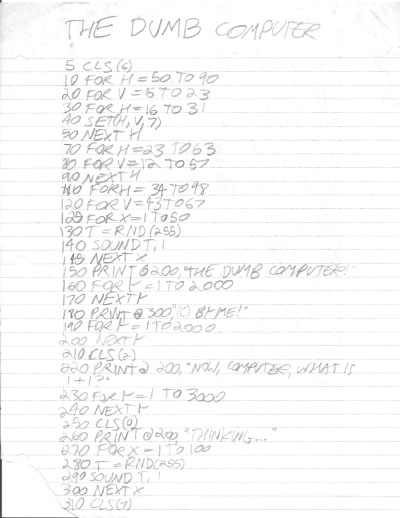
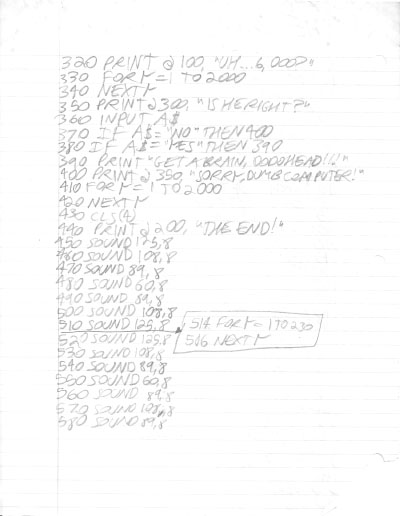
THE DUMB COMPUTER: Reproduced in its entirety here, it's a program where you ask the TRS-80 what 1+1 is and it fails to answer correctly. Clearly, I didn't think much of this machine.
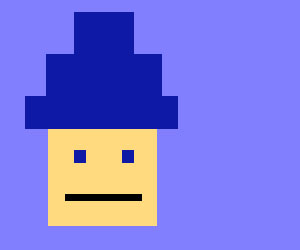
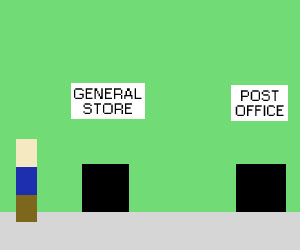
Artist's
renditions reconstructed from memories
WIZARD'S DILEMMA
A pretty simple text-based program, though there were blocky
illustrations. A wizard takes a vacation in Idiotville, but an
Idiot takes his teleporter box and hits the button, leaving the
wizard stranded. You are then presented with a whopping 14
choices as to what the wizard should do next -- and that's the
game; guessing at each of those choices until you picked the
right one.
SUZY-Q ROCK
You were a rock star named Suzy-Q (this was also the name of our
cat) who had to create a hit single. That was the backstory for
what was actually a simple music program where the keys gave off
different musical tones.
A LITTLE STROLL
In this game you played as "Mighty Morphin Power
Farmer," a three-square-tall figure equipped with ninja
moves and a pitchfork you could twirl around like a katana. Your
goal was to explore the streets and, ultimately, stop the
Antichrist from blowing up the town's only ice cream parlor.
This was an ambitious attempt at breaking out of text adventures and making a character I could move. I knew nothing of subroutines, and my understanding of variables was still a bit foggy. I actually programmed EVERY STEP the farmer had to take individually. The result was that I ran out of memory after writing enough code to make the farmer move two screens.
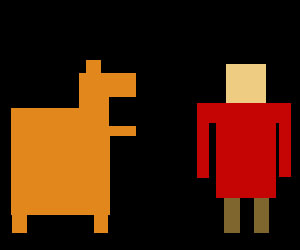
UNTITLED ANIMATED CARTOON
I didn't get very far with this, but the intent was to program a
guy walking around and then have a lion attack him. The program
stopped in mid-pounce, where I gave up.
By this point, I really wanted an Apple II. My school was full of aging Apples, though there was a back row in the computer lab of early-90s Macs that grew in size every year. My own homeroom had an Apple in the back, and I spent a lot of time there. I remember an Asian student turning toward me and asking with genuine concern if I was turning into a computer nerd. This implied I was something else prior; I guess she hadn't been paying attention. (I find it amusing that nowadays, you're considered abnormal if you DON'T have your face buried in a screen at all times.)
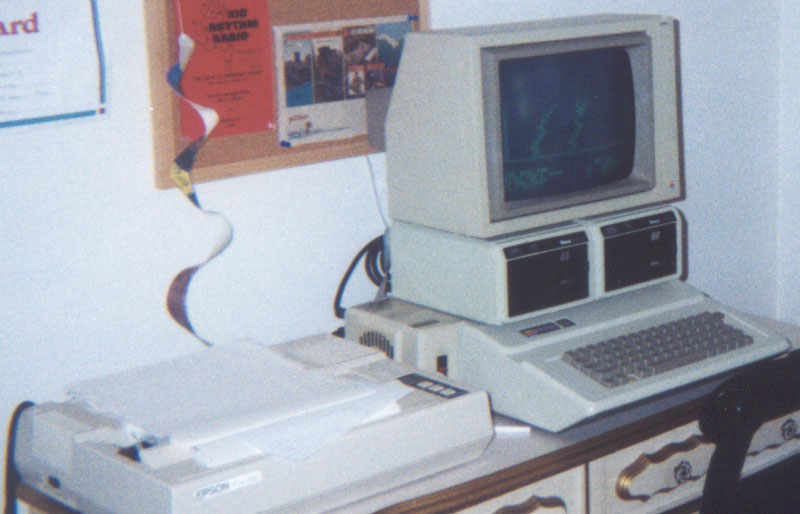
My
Apple during Week 1. If you look closely you can see
"Roadrace," a type-in program, displayed on the green
monitor.
Finally, I got my own sweet Apple IIe and put the TRS-80 to bed. It was so much better than what I'd been stuck with, but in terms of 1990's cutting edge, I hadn't upgraded that much. At the time I got the Apple, "Information Superhighway" was starting to become a buzzword and everyone was throwing out their 80s computers for sleek GUI-based systems that could access the Internet (how do you think I got the Apple in the first place? It was cheap).
But at the time, I really didn't care if I could get on-line (this was back when it had a hyphen). Me and that Apple had some great times.
I was finally able to try all the 3-2-1 Contact games, and while many were pretty lame, a few were worth the effort. And it didn't matter how bad my own programming skills were, because the Apple had so many great games on its own, and all of them were either free, or hacked to be that way.
THE COMPUTER STORE
You're greeted with a text description of a computer store and
offered to try three computers: the "Broken Record
Computer," which was just the old-school PRINT loop; the
"Repeating Computer," which repeated anything you typed
in back at you, and the "Forgetful Computer," which
just said "What?" no matter what you entered. Envy my
programming skills.
CHOOSE YOUR OWN ADVENTURE
In elementary school I made a few Choose Your Own Adventure books
out of stapled notebook paper. The first had no ending and told a
story in an endless loop; all the others had only one safe path
while the rest led to (hilarious) deaths and the message
"GAME OVER! YOU LOSE!" I knew enough to make some of
them into BASIC games, and so that is what I did.
WHERE IN THE MANURE IS CARMEN SANDIEGO?
This one began with a little ASCII graphic of what represented
Carmen running up a flight of stairs. One stair broke in the
middle and she tumbled into a pile of hashtags meant to symbolize
manure. Then you had to guess which part of the manure pile she
landed in. The opening scene had animation AND sound effects; my
power was increasing.
MESS-A-SKETCH
A program that simply acted like Etch-A-Sketch. You could draw
with the arrow keys and change colors with the number keys. I
couldn't have made this when I first got the Apple -- I didn't
know enough. By this point, I was really getting the hang of
variables and had embraced the power of "X=X+1"
equations. However, I was about to get a "real"
computer and my days with the Apple were in their sunset months.
JOHN MCENROE TENNIS
The most involved, complicated (and also last) game I would ever
program, "John McEnroe Tennis" starred the famous
athlete who swore all the time and blew up at everybody. If
somebody like that hadn't existed I never would have made a
tennis game at all; the whole point was to amuse myself by
creating a program where the opposing player yelled at you if you
missed the ball and also yelled at you if you hit it.
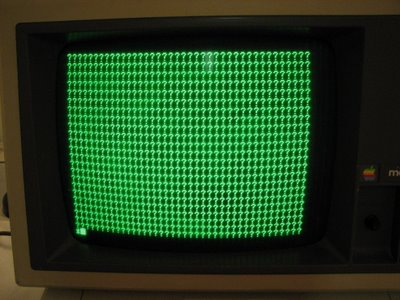
When I got the Apple, the TRS-80 saw the bottom of the trash bin and every game I'd programmed for the machine went with it. When I finally had access to a modern, modem-ready computer with a hard drive and a little calculator in the "Accessories" folder and everything....I kept the Apple around for a couple years, but I didn't touch it much, and even less so when one of its disk drives quit reading properly. When my uncle asked if I'd pass my computer down to my little cousin, I didn't see why not.
A couple years later I found out you could emulate the Apple II on a modern PC, and that Apple floppies could be converted into ROM images. I asked my uncle where my disks were. He said they were thrown out a while back. D'OH!
To this day, one of my biggest regrets is giving my cousin not only the disks with popular programs (those I have found since in emulation), but the programs I wrote myself and can never get back. I threw them into the pile because I figured they'd be gone anyway; it wasn't like any modern computer would have a disk drive for floppies that old. Before I gave it away, I DID hold a camcorder to the Apple monitor and made a tape of "John McEnroe Tennis" in action. Then I deleted that portion of the tape. Boy, was I stupid.
The Apple during its final days. It had a
color monitor by that point.
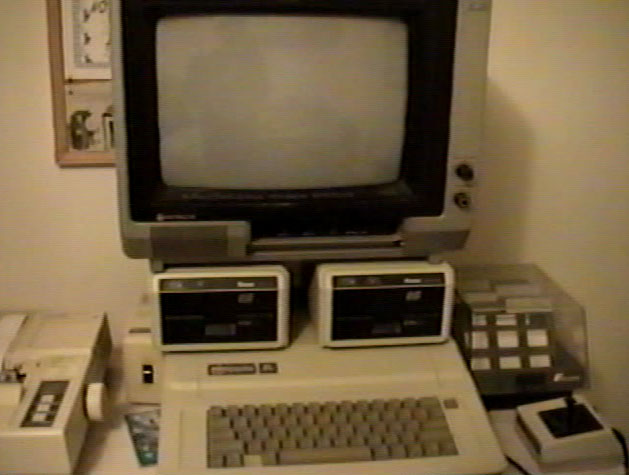
BUT THERE'S A TWIST!
A couple weeks ago I was down in the basement, sorting out the contents of some old boxes, when I found it: a container storing about ten Apple II floppy disks. I hadn't given them all away! I'd forgotten one! And on one of those disks was several of my old programs!
I found an Apple enthusiast's message board and announced my find. I got a few offers of conversion, chose the nearest offer, and sent the disks away. A week later the old disk with my programs was in my inbox, ready to emulate.
So....guess what. Today you get to play with it. I've uploaded the ROM and as soon as you grab the plug-in from Virtual Apple, you can play it right on your desktop or laptop through your browser. You get to experience for yourself, firsthand, my mid-90's hacker skills.
And boy, are they embarrassing.
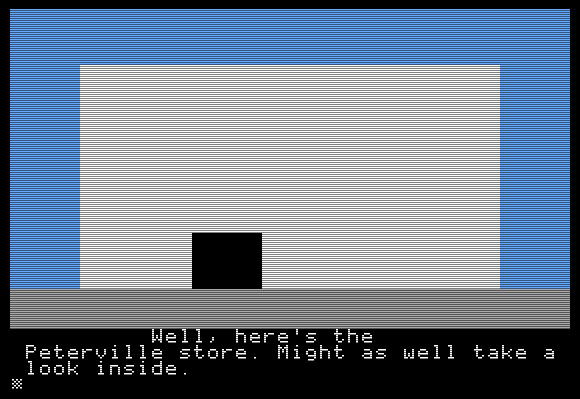
I was relieved to rescue a bit of this lost piece from my past, to be sure, but....eeesh. I was just barely fourteen when I created all this and it shows...badly. This is titled "World's Weirdest Disk" and though I've found weirder ones since, it's a top contender. The centerpiece is "Peterville," a text-based journey filled with terrible jokes and dated references. Several type-in programs are also here, including some 3-2-1 Contact ones like "Maze Craze" (which isn't bad) and a version of "Tic-Tac-Toe" that doesn't work -- the AI is off and it can't calculate when it' s won (I entered exactly what they gave me). There's also a "Comics Catalog" with descriptions of every cartoon funny book I had drawn to date, most of which have never been released on this site. I doubt many of you will be enticed, though, by plot synopses like "In this one they go camping! In this one they go shopping!" The whole disk reeks of "no friends."
I also remember attempting to expand "Peterville" into an entire solitary disk, complete with an arcade-style attract mode. I made an impressive title screen, but gave up after several days of trying to spell out "WINNERS DON'T USE DRUGS" solely with BASIC line information (true). That version is gone.
If you haven't visited Virtual Apple for the plug-in, do it now....visit the page for any game and the download should start. Keep in mind old Apple games need CAPS LOCK ON to understand your keyboard presses. If the menu screen is unresponsive, turn Caps Lock off and then on again. That seemed to "unstick" it for me.
PLAY "WORLD'S
WEIRDEST DISK"
OR, RETURN TO APPLEPALOOZA
